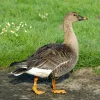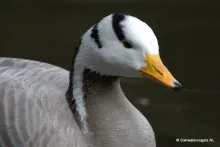
Bar-headed goose (Anser indicus)
Species name
- Dutch name:
- Streepkopgans
- English name:
- Bar-headed Goose
- German name:
- Streifengans
- French name:
- Oie à tête barrée
- Scientific name:
- Anser indicus
Scientific classification
- Order:
- Anseriformes
- Family:
- Anatidae
- Onderfamilie:
- Anserinae
- Genus:
- Anser
Description
- Description:
Male:
Head is mostly white, but is clearly marked with two horizontal dark stripes, the upper of which is broad and runs round the back of the head from eye to eye. The lower stripe circles the lower nape and is much narrower. The throat and very top of the bar-headed goose’s neck are white, while the hindneck is blackish and is separated from the dark grey foreneck by a white, tapering stripe running down each side of the neck. Breast belly and side flanks pale grey, The Darker on rear flanks, while the long wings appear almost white when in flight and are tipped with black. The yellow to orange-yellow bill of the bar-headed goose is also black-tipped. This species has brown eyes. yellowish to pale orange legs and feet.Female:
A female bar-headed goose is similar in appearance as the male, although the male is usually slightly larger.Juvenile:
are similar in plumage to the adults, but they are generally duller, paler and lack the distinctive horizontal bars on the back of the head. The bill, legs and feet of juvenile bar-headed geese are greenish-yellow and duller than those of the adults
- Behaviour:
Strong permanent pair bonds.
Standard Measurements
- Body Length (cm):
- The male (drake) of the Bar-headed goose measures approximately 71-76 centimeters. The female measures approximately 68-74 centimeters.
- Body Weight (grams):
- The male will weight about 1920-2840 gram. The female will weight about 1860-2680 gram.
The weight is notoriously variable and can only be used as indication!
- Note:
Bar-headed geese are hardy, totally winter-resistant and easy to manage. They are suitable for most collections and may be kept in mixed groups, but can be aggressive while breeding. A large area of well-sheltered water should be available, also grass for grazing. Additional feed of Lundi Regular floating Pellets should be provided, with plenty of green food always available - germinating wheat may be used in winter when grass is not available.
Bar-headed geese are fairly easy to breed. They prefer natural cover or a kennel-type or wigwam nest box and use nest sites on islands including wooden nest boxes on anchored floating platforms - may tolerate second pair on same platform if boxes back-to-back. They normally lay eggs in April to May, but the start of laying may be delayed after a long cold winter; they may also lay a second clutch. Goslings may be parent hatched and reared, although this may not result in a high survival rate. Bar-headed goslings are not difficult to rear, although survival is decreased in rain and cold.
- Breeding:
- The female Bar-headed goose usually lays from 4-8 white eggs and incubates them for 27-30 days.
- Artificial incubating:
The ideal relative humidity for incubating most waterfowl eggs is 55% (ground nesters) and 40% (cavity nesters). The temperature is usually 37.4°C. Set ventilation as recommended by the incubator manufacturer. Eggs must be turned, either automatically or by hand, a minimum of 4 times a day. As the duckling develops there is a loss of water from the egg and the air sac gets bigger. In normal development of an egg with a 27-30 days incubation, the air sac occupies about a third of it three days earlier. Cleanliness is vital and ideally eggs should be moved to a separate hatcher at this point, where the humidity should be increased to 65% and even higher once they have pipped internally.
- Bird banding:
- Recommended closed leg band ring size for the Bar-headed goose is 16 mm.The leg band ring can only be applied on a young goose at around 12-14 days old.
- It doesn't matter what leg that you band, but it's good to have a consistent system. Suggested: Left leg = Female, Right leg = Male
- Rearingfeed:
-



Floatable special rearing feed for all types of aquatic ornamental fowl - especially for the cultivation of trees as well as greening ducks.
This well-balanced complete feed with 20% protein content convinces above all by its good compatibility and forms the basis for visibly healthy growth from day one.
Made exclusively from wholesome and selected raw materials, Lundi Micro Regular is also ideally suited for the year-round feeding of waterfowl.
- Maintenance food:
-





Lundi Regular with a protein content of 20%, valuable Spirulina and high-quality by-products is optimally balanced in its composition maintenance food for water ornamental fowl of all kinds. Especially green teal and Whistling ducks that are not dependent on a very high protein content, are well supplied.
Lundi Regular contains all the minerals and vitamins in full form that are important for the animals. Therefore also suitable as breeding food.



